After joining Roy Wilburn to harvest tomatoes in his garden last June, which I wrote about in the post, “Learning from the California Gardener of the Year,” I was spurred to try his method of supporting tomato vines. Roy uses a specific style of stake-and-string support that goes by other names, or is at least very similar to methods with other names, including the basket weave and Florida weave.
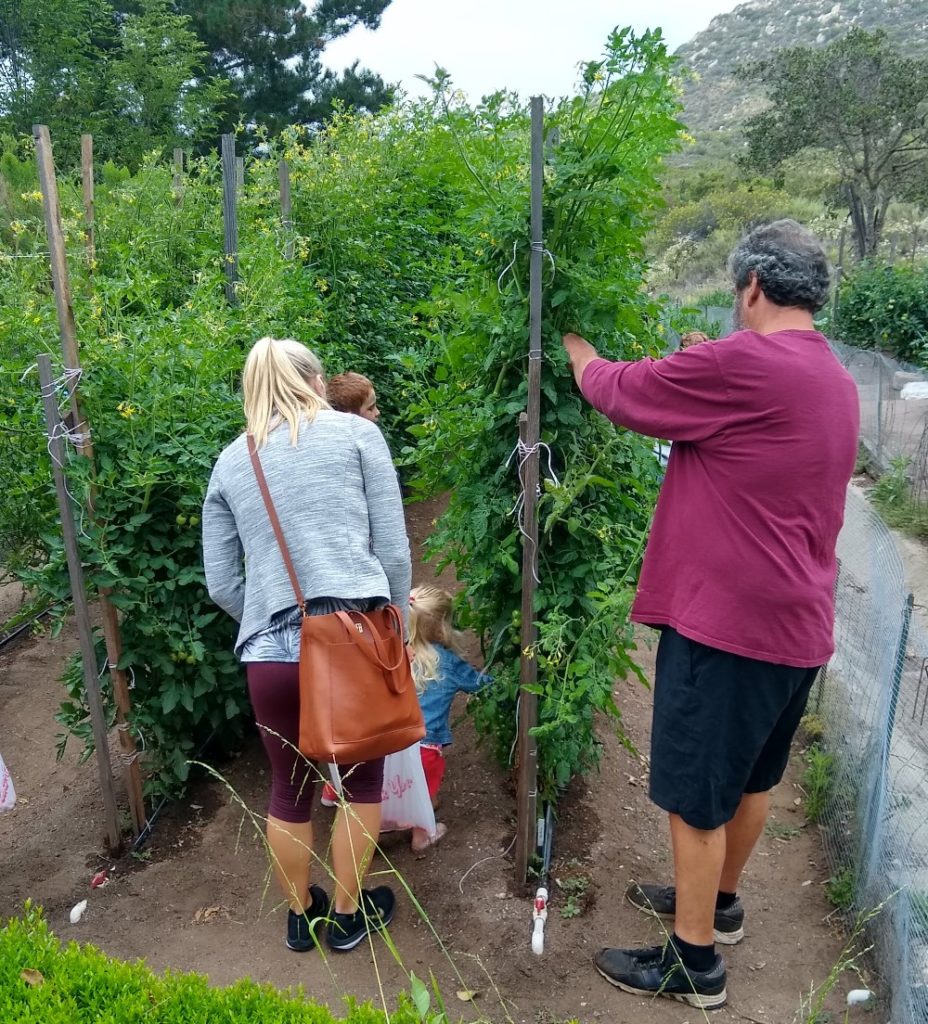
Summary of stake-and-string method
In this method, you sink stakes between approximately every other plant down a row, and then you run string on either side of the plants in order to prop them up.
Many times in the past, I had used stakes and strings to support tomato vines, but I’d always used them to build wider, three-dimensional, stake-and-string cages.
This method is different. Here you are trying to string the tomato vines up into a vertical plane. You’re cinching the string tight and bunching the vines into a narrow, upright shape.
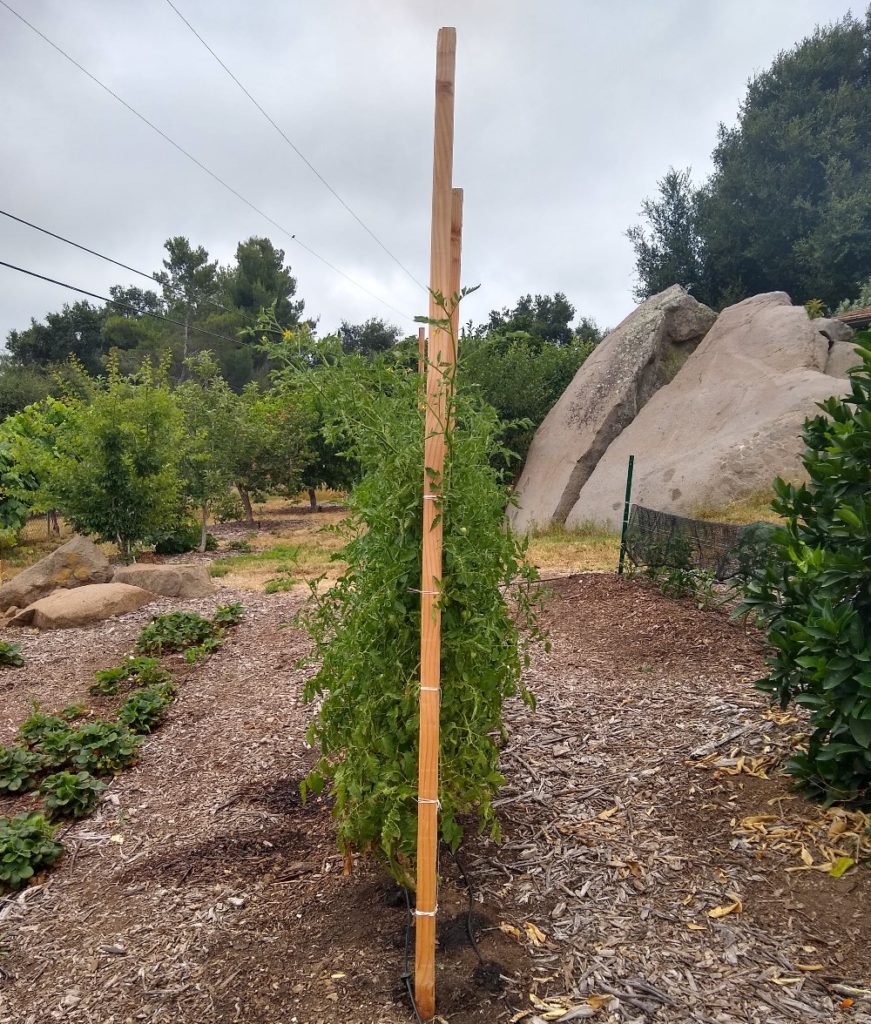
Summary of cage method
For some years, my standard method of supporting tomato plants has been with cages I made using concrete reinforcement wire. The cages are two feet in diameter, and they can be used on any type of tomato plant. For vigorous types like cherry tomatoes, I just use taller cages or stack one on top of the other as necessary.
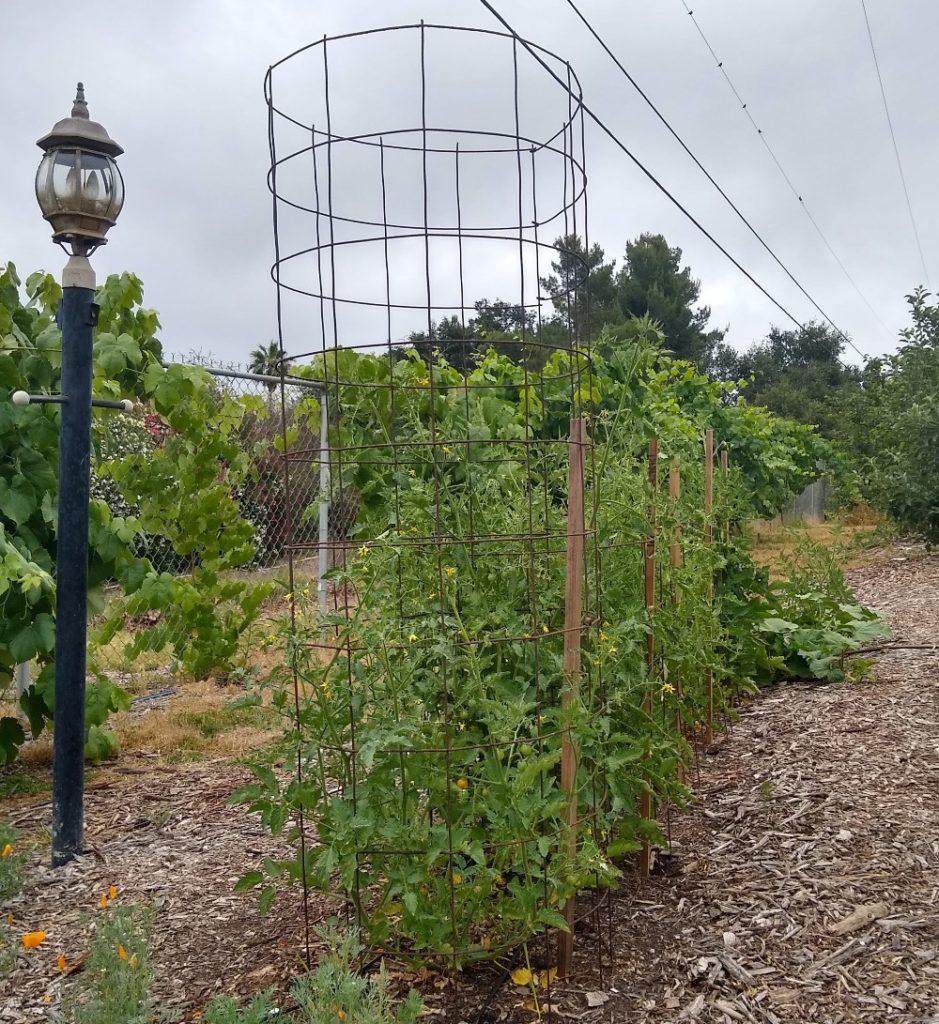
This spring I planted two beds of tomatoes, and I supported one with stakes and strings, the other with cages.
Here on the verge of summer’s official start, I’ve started to harvest from both beds of tomatoes and can compare the support methods. Which is easier to build and maintain? Which provides for easier harvesting? Which will be easier to remove and store?
Stake-and-string method
Unquestionably, the stake-and-string method takes more time and work to set up. Initially, you pound stakes into the ground, and then you must periodically run strings between the stakes to hold up the growing vines.
There’s also a bit of skill required to properly tie up the strings. Here’s a video that I’ve found useful, showing how this can be done fast and well.
Because the plants are propped up into a vertical hedge with the stake-and-string method, the growing tomatoes are more exposed to the sun so on hot days I’ve thrown a piece of 30-percent shade cloth over the plants to protect the fruit from sunscald. But also because the plants take the form of a hedge and expose their fruit, the tomatoes are extremely easy to harvest.
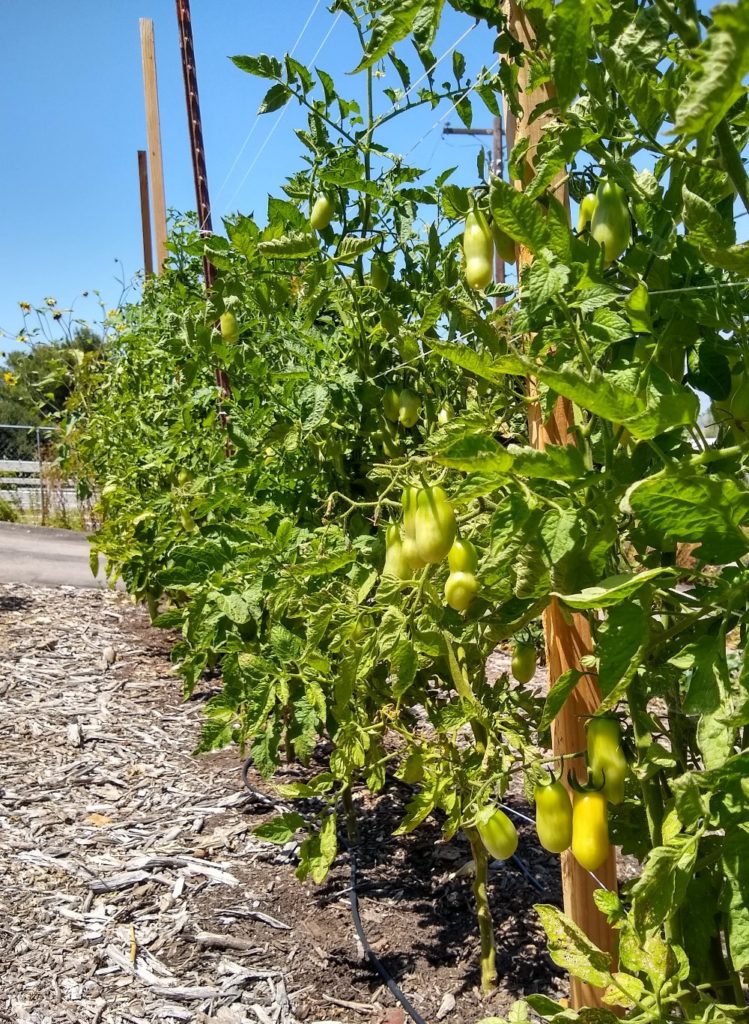
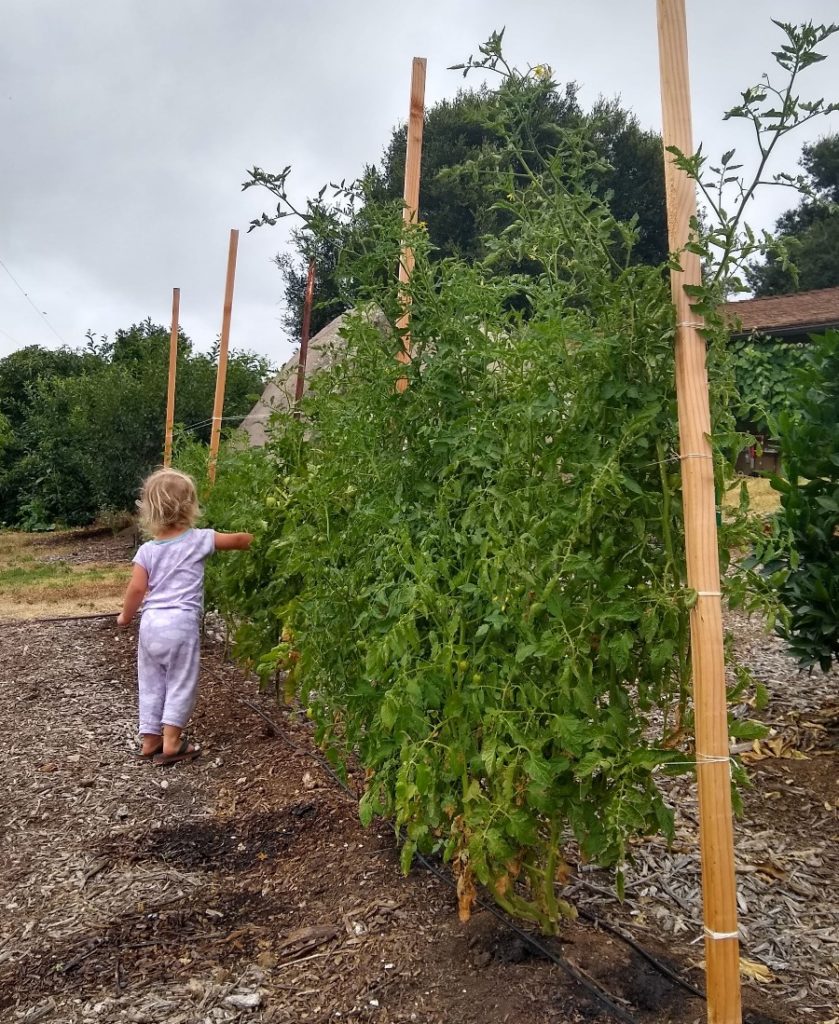
Not only are the ripening tomatoes hanging out for easy picking, but there’s not much foliage to cover them so as soon as they turn color they beam like beacons. I even spot tomatoes that are ready to be picked while still standing up at the house.

Cage
All is reversed with the cages. To install one, you simply place it over a tomato plant. Since my garden is on a slope I also add one more element though, which is to drive a stake into the uphill interior of the cage so it doesn’t fall over.
While there is no stringing and tying necessary, you do have to walk by the caged tomato plants every few days and push the vines back into the cages. They constantly try to escape and sprawl.
The real effort involved in using cages actually comes at harvest time. The tomatoes are only partly hanging on the outside of the cages.

Mostly they are inside, and sometimes they are deep inside such that you have to snake your hand through a tangle of aromatic stems to locate and pull out ripe tomatoes.
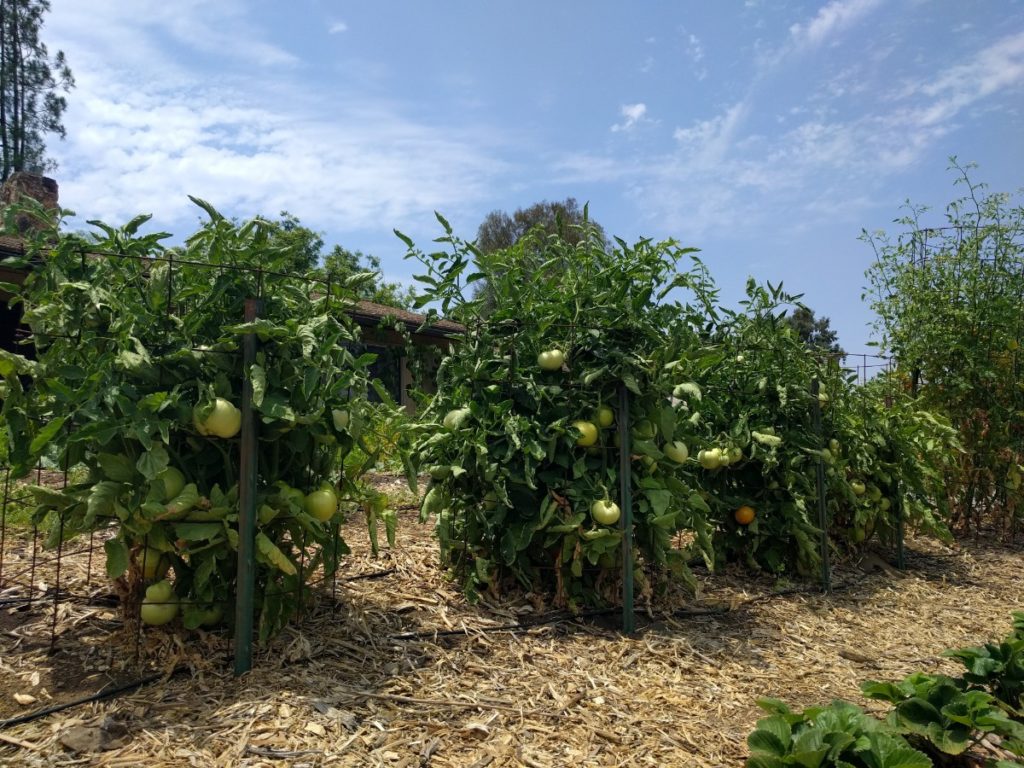
The benefit of this dense foliage surrounding most of the tomatoes is, however, that the fruit is better protected from intense sun. I’m in an inland, elevated location (Ramona, about 1,400 feet) where the days are hotter and the sun more powerful than some other parts of Southern California so I appreciate this, but I do understand that sunscald on tomatoes isn’t a concern for everybody.
When the caged tomato plants are done, it’s nice not to have strings to deal with. The cages can be lifted up and off the plants, often with the help of cutting some stems that have wrapped around them. With the staked and strung tomatoes, I know that I’ll have the extra step of clipping and pulling out a bunch of strings before being able to remove the stakes and old vines. I’ll also have those pieces of string to dispose of whereas the cages produce no trash.
The stakes will take less room to store than the cages though. I use these tomato cages to support other vegetable plants such as beans and peas, but I always have extras to store and they are bulky.
Preliminary conclusions
Right now, at early harvest time, I look at the tomato vines that I’ve supported with stakes and strings with kinder eyes than those in cages. But during the prior weeks of stringing up the vines, I was annoyed. It had been so much faster and easier to just plop down the cages. I questioned whether I should have bothered trying this stake-and-string hassle.
Today the payoff of convenient harvests, especially for my kids, has me thinking that the effort was worthwhile and as my skill at the stringing process improves, the method has the potential to become my new standard.
Timing of this post
Wouldn’t this have been a better post to put up back in March, when we were planting our early tomatoes? Late June is a little late to plant — and therefore care about supporting — new tomatoes, no?
No. Late June is a perfect time to plant late tomatoes, or what I often think of as “fall tomatoes.” Often, those March-planted tomatoes fizzle out around August. But if you plant a few new plants now, near the summer solstice, you’ll be sure to have tomatoes to pick going deep into the fall.
(Here are reviews of the tomato varieties I grew last summer, in case you want to try any for fall production.)
More on cages and stake-and-string supports
“How to tie and stake tomato plants” by Brad Gates of Wild Boar Farms in Northern California is a video showing the stake-and-string method starting from the first stringing.
“Trellising and crop support systems for tomatoes” by Andrew Mefferd for Johnny’s Selected Seeds is an article describing the why and how of the stake-and-string method.
“The best way to support tomato plants” is a post I wrote that shows some more cages and links to a video about making the cages.
A list with links to all Yard Posts is HERE




I caved and bought a few Texas tomato cages. They are far too expensive, but do a great job of supporting the tomatoes. And, because they are hinged and collapse, they are easy to store simply hung on a nail or two during the winter. So, if you have a little extra spending green, check out their website: http://tomatocage.com/#xl_xr_page_index
Hi Barbara,
Thanks for mentioning those. A friend uses the Texas tomato cages and loves them because they collapse also. He didn’t like how much they cost, but he sure likes using them now that he spent the money.
Check out this method of attaching to a vertical string with clips: https://www.youtube.com/watch?v=GBDqskBk3lQ Have not tried, but looks pretty cool. Starts about 7:25 in the video.
Hi Jane,
I’ve never tried clips, but they do seem like they’d work well. When I grew tomatoes up hanging strings, I just twirled the vine up the string without any clips or ties at all and it worked fine though so I wonder if the clips aren’t overkill. Maybe they save a little time and labor?
In this post, there’s a photo of some tomatoes I twirled up string under my eaves one year: https://gregalder.com/yardposts/green-bean-shade/
Thanks, Greg. I’m looking for anything that will vegetable gardening easier and more compact. Downsizing veggies in favor of high-density fruit trees. I also read the rest of that post and have a comment about your windows. We have some West-facing windows and walls that get killer hot. Window film helps a lot, but what really keeps the temp down in the room is reflective aluminum foil insulation. Cheap to make panels – used the type that has bubble wrap between layers of foil leftover from insulating my garage door. Version 2.0 will be to try to attach non-bubble wrap reflective insulation to the back of fabric blinds.
Hi Greg,
This was a great article! In the past, I’ve mostly caged our tomatoes, but this is the first season we are trying stringing/trellising them using plastic clips.
I have to say that it has taken much more labor to weekly go through the rows and clip them to the vertical string. Also, we have been trying to keep them in check by pruning the suckers as well.
As they begin to ripen I am having major problems with birds getting to them before I can. They are very visible in this staking method (as you mention), and I’m finding it to be a downside. I really prefer not to put up bird netting, because in the past I’ve had to untangle birds and lizards from it…some of whom died before I could do so.
All in all, I have to say that for our location and circumstances, I think caging is a better bet, and next year I’ll go back to that method. It’s always fun to experiment, though, and I know stringing them works well for so many people.
I tried the “drop string” method for the first time. Ran a length of wire overhead, basically a tall clothes line, then ran a long length of paracord up from a stake in the ground, up to the string, and back down to a stake at the next plant, and so forth. One long zig-zag string that looks like this
_____________<— Overhead wire
/\/\/\/\/\/\/\/\/\
* * * *
* = plant
Confused yet? Google "growing hops" and see images. Except for the ends, each plant gets two strings to climb.The clips work well and are cheap. Been using cages for years but they do make picking tricky. Drop string lets you prune suckers and water closer to the stem, and just get closer to your maters!
Cool, Randy. I know exactly what you’re describing. I’ve visited hops farms in Oregon, and one year I grew tomatoes up strings hanging from the eaves on my house. Here’s a photo of that: https://gregalder.com/yardposts/green-bean-shade/
I’ve been afraid of trying the drop strings in full sun at my place because I get sunburn on tomatoes unless the fruit is well shaded by foliage, but I’m glad you’ve reminded me of this method and maybe I should give it a try and see if 30-percent shade cloth over the row on hot days will protect them enough. I love the advantage of being able to see and pick the fruit so easily.
What about a combination of the methods? Use hog fence/cattle panels or concrete wire in an extended natural form, as if fencing in a property. Use stakes to support it upright, and should only need a few compostable strings to prop up tomatoes.
My garden is still in preparation stage, but I’m planning on using cattle panel tunnels from one raised bed to another. Should be whimsical, and work for multiple rotating crops. Have you tried cattle panel tunnels?
Hi Maureen,
I love the possibilities. When you say tunnels, are you thinking that each end of the tunnel will be in a raised bed and then you’ll be able to walk under (through) the tunnel? That could be fun.
One year I did a miniature version of that where I laid one of my cages on the ground horizontally near a tomato plant, the plant grew over the top of the cage, and my baby daughter would go crawling into the tomato tunnel, sit up, and snack on the hanging cherry tomatoes. I took some fun pictures of her in there that summer.
I’ve never tried anything with cattle panels, but I don’t see why they couldn’t be useful in supporting tomatoes somehow.
Greg: I’m using cattle panels & those little white plastic “tomato clips”.
For your readers, I purchased the panels at at Tractor Supply for around
$30 ea. They are about 50″ x 16 ft so take bolt cutters. The wire is heavy duty
so they should last a lifetime. Buy 2 ea heavy duty 5 ft. fence posts for each
8 ft. section and install the fence about 1 ft above the ground.
For your pole or runner beans, buy longer fence posts and install fencing vertically or you can make tall tunnels between your beds
How do you dispose of your vines? It seems to me that if you use an organic string like jute you could dispose of that right along with the vines instead of having to extract it. I only grow one plant each year ’cause I don’t like tomatoes — but I do like pico de gallo, so I get just enough enough from one plant for that. I use two commercial coneshaped tomato cages interlaced to make one wasp-waisted cage.
Hi Lynne,
Smart how you connect those cone-shaped cages. I suppose they remain standing well as long as you’ve placed a stake on them?
I compost my old tomato vines in one way or another. I’ve mostly used jute or sisal twine in the past, and I still have some on hand, but I’ve grown tired of how easily it breaks under tension. The nylon twine is just so much stronger.
In addition, the jute and sisal twine doesn’t break down in my compost piles as fast as I’d like. Maybe it would in a large, hot compost pile, but that’s not usually what I have going.
Maybe I can buy higher quality twine made from those natural fibers? I should look into that.
I’ll have to give it a go. One test I did was digging a little deeper of a hole on the transfer of my plants and placing a 6×4 chunk of fish under the plant, old yellowtail from my freezer to be exact. The plants with fish shot up faster and are far healthier. Apparently tomatoes are pescatarians. 🙂
Nice one, James. I do believe it used to be an accepted planting practice to throw some fish guts in the bottom of planting holes similar to what you did. Good to hear that your tomatoes are demonstrating that they like it. What’s the big difference between doing that and using a fish emulsion fertilizer anyway — except that it’s way cheaper if you’ve got old yellowtail in the freezer?
Hi Greg,
Several years ago I happened upon a man who used PVC pipe for his tomatoe cages. It was genius. He doesn’t glue them, he just dry fits them together. At the end of the season he just pulls it apart. I’ve been using them since then. The web page below is an example, but not his. Note again he does not glue his, as the web page indicates to do.
Hi Karin,
That’s clever. Cheap, light, reusable, easily stored. I’m guessing that you find that it effectively supports the tomato plants too? My only wonder is whether the large openings the cages would have would not contain the plants well enough.
I have put stakes around a new Wurtz avocado to which I have clipped shade cloth. Would it be ok to train some tomato plants up the stakes to shield the tree from direct sun?
Hi Robert,
That might end up shielding the new avocado too much. I’m imagining a rampant cherry tomato vine crawling all over a small avocado tree. I’m sure it could work if you used a smaller type of tomato and/or pruned the plant as necessary so it didn’t shade the tree too much. You want to make sure the tree is getting enough sun to grow and flourish.
I’ve tried both methods in the past. The post and string is a pain in the keester, so I still use cages. I first used the cone shaped cages. I don’t have enough room to store them and the volume was too small, so I bought some cheap galvanized folding square and triangle cages. They were too flimsy. Lowes has some nice painted heavy wire folding cages and they work great. Like Greg stated, no matter what cage you use you need to drive a stake into the ground and tie the cage to it – I use velcro straps to attach it and I use electrical conduit – 1/2″ galvanized because it is cheap and strong. As the plants grow you simply push the stems into the cage and when they get out the top you need to pinch out the growing part. This puts growing energy into the fruit rather than stems and leaves growing everywhere. My favorite tomato is “Betterboy” variety and the stems can grow 6 feet long if you don’t pinch them out. I allow all leaves to cover the fruit to prevent sunburn. When the stems are above the cage about 12″ remove the flowers at the top because the fruit there will get sunburned and it is a waste of plant energy. You just want the leaves at the top for shade. If anyone has a method to keep the rats from eating the tomatoes please let me know.
Hi Richard,
I like the tip on pinching off the top growth. I’ve never tried that. I’ll play with it this summer.
Hav a hart trap at the base of whichever plant is being attacked. I do the same for whichever stone fruit is currently being attacked. Neighbors cat does wonders, too. Also, the reason. For the hav a hart trap is that a regular snap trap would get my dog and the chickens.
I use the standard round cages. For plants that grow big I hog ring another cage to the top upside down and drive a piece of old pipe in to keep it all from falling over. Roma’s barely need a cage but it helps if you grow them close to each other. 8 years ago we planted so many I had the kids sell them out front. This year we went heavy on saucing types. Even near SDSU the afternoon sun can be brutal and scald them so the shade they provide themselves is nice. I’m horrible about pinching suckers so at the end of the season I have a lot of vines. As for late planting, that’s exactly what we’re doing tomorrow, probably gonna put 6 more fancy tomatoes in near a south wall and plant 10 more Roma’s.
Hi Gregg; As a reader above stated; I also use 1/2” dry fit PVC to stake/suspend my cherry tomato’s. I have a 3’ x 1/4 piece of rebar at each end vertical post then use an assortment of elbows and 4-way cross pieces to extend out 10-12”’s where needed. Once positioned over the plant as I like i use green plant tape to “tie’ up the tomato’s vines where needed. Works very well and I disassemble and re-assemble every year. I had bad luck with cages, A little clumsy but i ended up damaging more tomatoes than anything so I experimented and went with the PVC witch is very customizable to individual needs. Long time reader, Joe I’d end a picture but haven’t figured out how?
Thanks for that detailed explanation, Joe. Sorry I don’t have the capability of adding photos in the comments. But your description is clear.
Hi thanks for the great information
I’ve tried both structures, here in Australia we have fruit fly ( which lay eggs in the immature tomatoes which then turning into grubs destroying the fruit.
I have to exclusion bag every bunch of fruit, if I want to get any tomatoes.
So the trellis and string method is the one I have to use for easy access to each bunches.
I could spray chemicals on them every few weeks to deter the fruit fly but as a home gardener I don’t fancy doing that.
I can only dream of freely growing tomatoes with no bagging or spraying necessary.
Hi Jasmine,
My goodness, I never knew tomatoes were such a pain to grow over there. I feel so guilty about how easily we grow them. Thanks for pointing this out.
Hi Gregg: Sorting my mail and looking at all your great weekly posts. Its late in the year and planning tomato’s for next year. Can you recommend the best Tomato fertilizer for San Diego coastal (Oceanside, CA). I have poor soil so I dig a large hole and refill with good soil/amendments. I use SMG 18-18-21 and would appreciate any suggestions. Its all I’ve ever used and may have burned my Sunchocola’s this year. Any comments appreciated, Thanks
Hi Joseph,
I’ve seen people get great results from tomatoes in soil that has been fertilized in many different ways. I only add compost (green waste and some chicken manure), but others fertilize more strongly with things similar to what you used, and then I’ve also grown tomatoes and seen others grow tomatoes in unfertilized, unamended soil very well. My guess based on all of this is that tomatoes aren’t picky and can do well as long as their sunlight and watering needs are met.